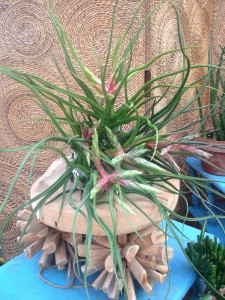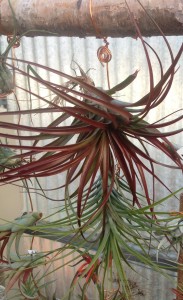Tillandsia or air plants, are very cool indoor plants and the largest genus in the bromeliad family. They’re considered epiphytes, absorbing moisture and nutrients through the air, using plants or other structures as support.
Like other bromeliads, their life cycle ends after blooming, but new plants, called pups, form around the base of the plant. They do not require soil to live – the roots help them to attach to a host, whether it be on a plant, tree or piece of wood. They are not parasitic, meaning they won’t harm the host plant, rather, they use it as a support, taking nutrients from the air and water you supply.
.

hanging air plants…

air plants – we think they will look great attached to the bark pieces here!
There are tillandsias with rather stiff, gray or faded leaves and those with softer, greener foliage. As a rule, the stiffer leaved, gray ones will need more light but less water – and those with softer, greener leaves tolerate lower light levels but appreciate more moisture.

look at the contrast in colors here!
In their native habitat, tillandsias live on trees, so they get light, but it’s diffused through the canopy. Try to emulate this in your home, giving them strong, but indirect light (not right in a window, as that could burn the foliage and cause it to dry out faster too) or place them outside through the summer, in a shady spot, or at most a location with morning sun and dappled light.
As noted, the gray leaved tillandsias need less water than the softer leaved green ones but when you water ((roughly once a week), take them to your sink and water thoroughly, shake the excess moisture off (you don’t want water ever sitting in their base) and return them to their home. They need to dry out between watering. If they get too dry, they’ll have curled or rolled leaves that look shriveled – you don’t want them to get to that point!
If you display them outside, bring them indoors for the winter when temps drop below 40 degrees. Don’t worry about fertilizing – they are susceptible to over feeding – best to leave well enough alone!
Stop in and take a look at these cool plants – we’re sure you can find somewhere to try one or two – they’re too fun not to!
If you follow us on Instagram or Facebook you’ve probably seen a new series of shop videos – if not, follow us and check them out! They’re also on our YouTube channel under Oak Street Garden Shop – if you’d like to see more, subscribe!
By Kris Blevons

